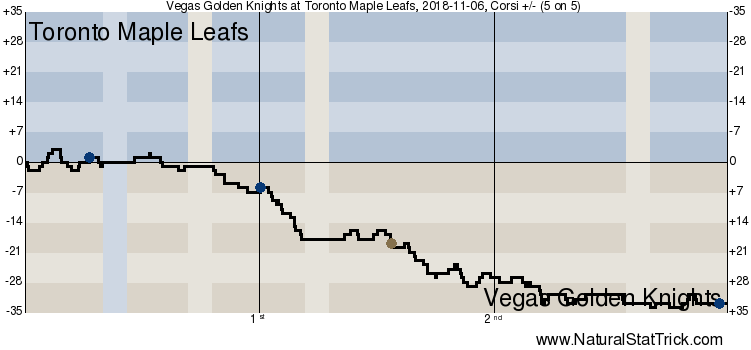After losing four of their previous five games on home ice, the Toronto Maple Leafs picked up a much-needed win at the Scotiabank Arena over the Vegas Golden Knights on Tuesday night.
Your game in ten:
1. The Leafs turning their home-ice struggles around had to start with better starts to games and they got that in the first period tonight, scoring first for just the second time in nine games at Scotiabank Arena. The difference was the early urgency as opposed to wading into the game.
Mike Babcock mentioned in the post-game that he hopes the win tonight — as unglamorous as it may have been — “loosens” the team up going forward at home. Mitch Marner said after the Pittsburgh win on the road that the team just needs to relax and have fun more on the home rink. The discussion in the room has clearly centered around how tight the group is at SBA (sometimes the opposite has appeared to be true with how cute they’ve been — over-passing the puck at times — but that clearly is the sense in the room).
2. And it was the third line — a work in progress since the start of the year, even with Nazem Kadri on it, but particularly with Auston Matthews/William Nylander missing and Par Lindholm centering it — leading the way with a couple of great early o-zone shifts, including the slump buster for Connor Brown to open the scoring. While that line faded as the game wore on like the rest of the team, it’s great for Brown’s confidence to score a goal with a goalie in the net and it’s also encouraging that Andreas Johnsson’s legs are coming alive on the forecheck — he’s looking more like the courageous disruptor we saw last season of late.
3. Also noticed that it was the bottom pairing on the ice for the 1-0 goal and thought it was interesting that Par Lindholm is a 58% CF with Travis Dermott on the ice and a 45.5% without him (o-zone starts are about the same with and without). Johnsson is a 70% CF with Dermott and a 40% without (he’s shared about half his ice time with him and half without, although he has seen more o-zone starts in the half with Dermott than without). Those splits largely hold true for the fourth line as well.
On the opening goal, the third-line was buzzing in the o-zone and the puck was flipped out by Vegas. Dermott was gapped up tight in the neutral zone, settled a bouncing puck down, and dished to Igor Ozhiganov, who threaded a cross-ice pass to Johnsson at the blue line. The line transitioned right back onto offense before scoring shortly after.
It was a small play, but an example of what Dermott does so well — settles things down and gets the puck moving north cleanly and efficiently.
4. The tricky part is the handedness factor, but I’m curious to see how much longer the Leafs keep Dermott out of a top-four role. We’ve seen he can play the right and I think he can do it well at the NHL level sooner than later. Babcock will almost certainly wait longer than the fans or pundits would, though. And that’s not a criticism of Babcock — there’s a method behind it, and Dermott learning to kill penalties while being brought along at a patient pace at 5v5 is probably the right thing for his development in the big picture.
It’s not exactly the same situation to Rielly’s as Rielly was playing important top-four minutes at the time, but it’s not totally dissimilar as another offensive-minded puck-moving D who was reined in a little and taught how to kill penalties and defend before he was really turned loose.
Alternatively, you could keep Dermott on the left and start to ramp up Dermott and Ozhiganov’s minutes while taking some away from your top four and the Gardiner – Zaitsev pairing in particular, but slow and steady has (rightfully) been the approach with Ozhiganov as well.
I was going to point it out with video, but the excellent Ray Ferraro beat me to it on the broadcast — the other impressive part with Dermott (again, another similarity to Rielly here as far as their builds and conditioning) is how strong he is in his one-on-one battles and box outs. The 230-pound Ryan Reaves tried to bull past him to get inside positioning around the net late in the game and Dermott more than stood his ground.
5. The game is really easy for Mitch Marner with the puck on his stick right now — he’s constantly creating time and space and waiting until a play develops, and that comes from the new level of confidence. The game has really slowed down for him in his third year in the league. There were several great examples in this game — one in the offensive zone, where he held onto it an extra couple of seconds until Tavares opened up at the back post, and another where he sliced through a busy neutral zone by intentionally trimming off speed with an ’S’ turn before exploding up ice.
He uses changes of pace so effectively — gearing down, drawing in a defender, and then beating him wide; or the opposite, where he backs the defender off by making him think he’s going to take him wide, only to fade or wiggle away and use the time/space he’s created to his advantage.
He’s also generating strips tracking back and forcing turnovers on the forecheck simply by closing down time and space, sticking on a defender’s hip and giving him nowhere to go — it’s all angles, leverage, and strength on his edges (his size or lack thereof is irrelevant). Examples of both of the above-mentioned things in the same sequence:
I
Simply put, Marner has evolved into a dominant player over 200 feet game in and game out, with only one or two exceptions so far this season.
6. The Leafs really lost their way in the second period after the Marner goal, and while they limited Vegas as far as quality chances against in the third, it wasn’t a good final 35 minutes to the game overall, as Frederik Andersen took over as the first star the rest of the way. A lot of it had to do with all of the icings by the Leafs and their inability to generate controlled breakouts as Vegas turned up the pressure dials chasing the game.
It was again in large part a product of how often the Leafs flipped the puck out and unsuccessfully sought out the stretch pass — sometimes under duress, sometimes not — which brings us back to the same old debate that has been carrying on for the better part of two years now in Leafland.
Babcock spoke yesterday about how the available space is oftentimes in behind teams now with the way the opposition presses up on you in five-man units, and that’s true and understandable to an extent. It’s a great thing to have in the arsenal for a club with the Leafs’ team speed, but again, it’s the over-reliance on it that can be their undoing. You’ve got to have a tighter game with an effective chip and chase in your bag if you’re going to see games out properly.
7. My question here is where the disconnect is taking place. Either the coaching staff is perfectly content with Leafs forwards releasing the zone to try to create space while throwing pucks down the ice repeatedly regardless of the success rate, or the players aren’t getting it/have their own ideas.
John Tavares probably isn’t repeating anything the coaching staff isn’t preaching when he said this at the second intermission:
“We’ve just got to be a little bit more together — all five guys coming up the ice together, supporting the puck, and being able to be available for outlets. Second guys getting in on the forecheck and being able to sustain some pressure, and we’ve got to find some ways to get some pucks to the net and get to the middle of the ice.”
8. The Leafs generated just one power play in this game for the third time this season. They’re currently last in the league in power play opportunities per game with 40 in 15. There have been some missed calls on some nights, but you can only control what you can control and for their part in it, you can see why this might be the case in a game like tonight. They didn’t spend enough time generating o-zone cycle shifts, especially once they are in possession of the lead. Their 44.2% CF when leading is 21st in the league.
When you cycle on teams, it gets players going in opposite directions, forces defensive zone handoffs, and crosses up defenders. That’s when penalties happen.
9. This was a topic in our reviews at times last season and it came to a head when the Jake Debrusk goal happened in the third period of Game 7 in the Bruins series, but for all he does well defensively (with and without the puck… it does outweigh the bad), Jake Gardiner’s lack of trust in his own pivots remains a puzzle.
He tends to pivot early (sometimes the wrong way) and tries to defend skating forward. It exposes his heels and makes him susceptible to oncoming attackers cutting across his back and driving the net, or hitting a trailing player with a pass and easy entry into the home plate area. The easy zone entry for Vegas below led to a post struck followed shortly thereafter by the 2-1 goal (although the goal itself owes more to the lack of box out by Par Lindholm than the initial entry).
I
My theory is that it has to do with how late in his playing career Gardiner converted positions from forward to defense, although it should be something he’s sorted out by now.
10. Really hope it turns out to be better than it looked for Erik Haula. You hate to see that.
Thanks to everyone (especially all the Leafs fans) for sending in well wishes & support for Haula 🙌 https://t.co/EV5QYza5H1
— Vegas Golden Knights (@GoldenKnights) November 7, 2018
Game Flow: 5v5 Shot Attempts


































![New Leaf Anthony Stolarz on the opportunity in Toronto: “In Florida, I knew my role as a backup… Now, [Joseph Woll] and I are competing for starts… As a goalie, that’s all you can ask for” Anthony Stolarz, Stanley Cup win, now Maple Leaf](https://mapleleafshotstove.com/wp-content/uploads/2024/07/anthony-stolarz-sc-100x70.jpg)
